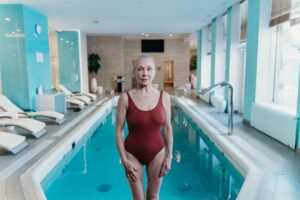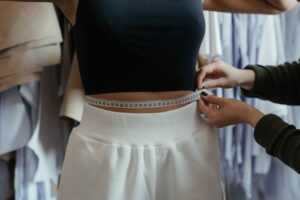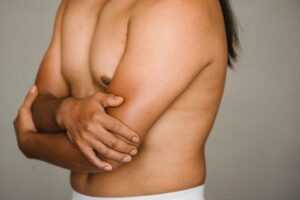Publicado por Dr MIguel Fernadez Calderón: 23/06/2025
Ponerse en manos de especialistas en contorno corporal es fundamental para un buen resultado en tu abdominoplastia en Madrid. Sin embargo, que la cirugía se convierta en un éxito depende de muchos más factores. Entre ellos, destacamos los cuidados del paciente en su posoperatorio. La manera en la que te cuides esas semanas puede marcar la diferencia. A continuación, te damos consejos sobre los cuidados tras una abdominoplastia.
What is abdominoplasty?
Abdominoplasty refers to a surgical procedure that improves the appearance of the abdomen. It involves removing excess fatty skin in this area and is popular among people who have undergone significant weight changes.
This procedure not only improves aesthetics, but also functionality, as it strengthens the abdominal wall.
In addition to the classic abdominoplasty there are other variations. For example, mini-abdominoplasty, vertical scar abdominoplasty or circumferential abdominoplasty.
What to expect on the day of surgery?
After an abdominoplasty it is normal for the patient to feel numb, tired and sore. From the first day of surgery it is essential to follow the indications and recommendations of the surgeon so that the postoperative period is as good as possible. The patient should rest for several days, keep calm and be patient.
Taking proper care after a tummy tuck is one way to ensure a successful recovery. In addition, the results are more likely to be maintained in the long term.
Pain management and medication
To begin with, rest is essential. Absolute rest at least the first and second day will help to reduce pain and swelling. At the same time, medications indicated by the specialist should be taken, which will also contribute to reduce discomfort and ailments.
First days of rest and medical supervision
The first few days after surgery are critical to ensure a successful procedure. So take the necessary rest time for the body to recover.
The patient will be resting, without exertion, but it is important to get out of bed and do some light walking to avoid clots.
As for medical supervision after abdominoplasty, this will be extended for the first 48 to 72 hours, either in the clinic or at home.
Use of postoperative girdle and drains
After surgery, the patient will have a bandage and will have to wear a compression garment for a few weeks.
The proper use of girdles, allows to keep the skin and abdominal muscles in place, so that they adapt to the new shape. In addition to other benefits mentioned below.
Benefits of compression
The compression provided by the girdle helps to maintain stability in the abdomen. This minimizes movement in the area, which could affect healing.
It also helps to decrease swelling and also helps to prevent fluid accumulation in the surgical area. Circulation in the area improves with compression, thus helping to accelerate healing and reduce the risk of complications.
In addition, the girdle can make the patient better able to withstand discomfort and feel less pain by supporting the muscles.
When to remove and how to care for drains
During surgery, drainage tubes will be placed in the patient to help eliminate fluids. They must be properly cared for to avoid infection.
For this, during the postoperative abdominoplasty, the area of the drains must be kept clean and dry. The skin around the drain can be cleaned with mild soap and water, preventing water from entering the tube.
The surgeon will be the one to indicate when the drain will be removed. This will depend on the amount of fluid the patient is draining.
What is the postoperative period after abdominoplasty?
Initial phase (first two weeks)
Care after abdominoplasty varies according to the postoperative period in which you are.
The first week your duties are simple. You must wear a girdle 23 hours a day, taking it off for one hour for healing. The wounds are washed with soap and water and covered with band-aids. Your surgeon may recommend some sponges (foam) to place under the girdle to improve the result of the operation.
No debes realizar grandes esfuerzos, pero sí debéis caminar por la casa unos minutos, varias veces al día. Si te encuentras bien, puedes salir a la calle, siempre acompañados, a dar pequeños paseos.
Una tarea muy importante consiste en apuntar todos los días el líquido de los drenajes. Así, el doctor podrá saber cuándo retirarlos.
Asimismo, es fundamental seguir todas las recomendaciones del informe de alta. Se te recetan medicaciones que debes tomar para prevenir complicaciones como dolor, trombosis o infección.
A finales de la primera semana tienes que acudir a la primera revisión en la clínica. Sí se puede, aprovechamos para quitaros los drenajes. Una vez os quitan los drenajes, ya podéis ducharos el cuerpo entero.
Intermediate phase (2-6 weeks)
Las siguientes revisiones en la clínica son la segunda y la cuarte semana.
Durante todo el primer mes es crucial reducir la tensión sobre la cicatriz del abdomen. En la cama debes dormir boca arriba, con las rodillas y el tronco flexionados. Cuando camines, hazlo ligeramente doblado por la cintura.
A partir del segundo mes, todo se vuelve más fácil. Llevas faja solo 12 horas al día. Puedes y debes hacer ejercicio, pero no abdominales. Entrena brazos, piernas y haz cardio, pero con calma y sin sobreesfuerzos.
Long-term phase (more than 6 weeks)
In the third month, you will have a new medical check-up. You will be able to lead a practically normal life. You can start doing sit-ups at the end of the third month. At the end of the month, it is no longer necessary to wear a girdle.

How long is the rest period after abdominoplasty?
A final de la segunda semana, puedes incorporarte a tu vida laboral, si esta no requiere de esfuerzo físico. Al final del mes, la mayoría de los pacientes podéis hacer vida prácticamente normal. No obstante, conviene evitar hacer esfuerzos físicos intensos hasta cumplir el tercer mes postoperatorio. Hasta entonces, tampoco se debe levantar mucho peso.
Pasadas unas 5 semanas de una abdominoplastia, puedes conducir sin problema.
Incorporación al trabajo
Luego de una abdominoplastia es indispensable seguir las instrucciones del cirujano para una recuperación rápida y óptima. En cuanto al reposo necesario antes de volver a la rutina laboral, se recomienda esperar entre dos y cuatro semanas. Tiempo que puede variar dependiendo si el trabajo es sedentario o si requiere de esfuerzo físico.
Actividades cotidianas y deportivas
La incorporación, tanto de actividades cotidianas como deportivas, debe hacerse de manera progresiva y bajo la supervisión del cirujano. En la primera semana, se debe evitar realizar esfuerzos y actividad extenuante. En esta etapa se puede caminar con precaución. Luego de la cuarta semana, se puede ir incorporando ciertas actividades más exigentes.
De la segunda a la cuarta semana pueden realizarse ejercicios de bajo impacto, y a partir del primer mes ejercicios más intensos. Para ejercitarse en actividades de alto impacto, como correr, saltar o hacer crossfit, se recomienda esperar entre ocho y doce semanas luego de la abdominoplastia.
Consideraciones en un futuro embarazo
Una abdominoplastia no interfiere en la capacidad de una mujer para quedar embarazada; sin embargo, para que la piel esté totalmente recuperada, se sugiere esperar al menos un año luego de cirugía de abdomen. De esta forma se evitan inconvenientes con la cicatrización y le habrás dado tiempo a recuperarse a tu musculatura abdominal.
Recordemos que el embarazo implica estiramiento de la piel y músculos, y por lo tanto es posible que se produzca flacidez en la zona, y para ello se requiera una cirugía de revisión.
Recommended activities and exercises
The incorporation of physical activity after abdominoplasty should be progressive, with the respective authorization of the doctor. At the beginning you should take it easy and gradually increase the intensity and duration of the exercise sessions.
Cardiovascular exercises such as walking are an excellent option. Swimming and yoga are two very effective exercises for strengthening the body and increasing flexibility, as well as pilates will help you strengthen your muscles. These sports should be practiced when indicated by the surgeon.
The same is true for other daily activities. So if you want to know when I can sweep and mop after abdominoplasty, it is best to consult with your doctor. Generally, you should wait at least three weeks.
Nutrition and postoperative diet

Recommended foods
A healthy and balanced diet will contribute not only to recovery, but also to maintain the results over time. Including fruits and vegetables in the daily diet provides the vitamins, minerals and fiber that the body requires. So do whole grains.
In turn, the consumption of lean proteins helps tissues to heal and muscles to be strengthened. Drinking enough water is essential to keep the body hydrated.
What not to eat after abdominoplasty?
It is important to eat and drink properly after abdominoplasty. A good diet will provide us with the energy and nutrients necessary to heal properly. However, there are certain products that we have to eliminate from our shopping list, for a good recovery.
Alcohol and tobacco are the first things to avoid, especially in the first postoperative month.
Los alimentos que comamos deben ser fáciles de digerir. Por eso, debemos evitar comidas grasientas, puesto que asocian digestiones pesadas; también evitaremos alimentos que nos produzcan gases (legumbres, bebidas carbonatadas…).
Our intestinal rhythm must function properly. Therefore, we have to avoid constipating foods. For this reason (among others) we recommend avoiding industrial pastries and refined carbohydrates.
Nos interesa no retener líquidos en nuestro abdomen. No conviene abusar del café. Tampoco de las comidas con mucha sal añadida.
Check also the price of a mastopexy in Madrid Spain at Sculpture Clinic.
Señales de alarma y complicaciones
Patients should be aware of the possible complications and risks involved in surgery.
Although it is a safe procedure, any surgical intervention can lead to some problems. Most of these, however, can be prevented if the surgeon's recommended post abdominoplasty care is followed to the letter.
Fiebre, enrojecimiento, dolor intenso
Si el paciente presenta síntomas como fiebre, piel enrojecida o dolor intenso que no disminuye con los medicamentos indicados, es importante comunicarse de inmediato con el cirujano.
Hematomas, seromas e infecciones
Si se observa la aparición de moretones, seromas o aparición de pus, esto puede ser signo de complicaciones que deben ser atendidas por el cirujano.
Management of swelling and fluid retention
Swelling is one of the most common side effects of abdominoplasty. It is normal to occur, but in some cases it can be more pronounced.
It is caused by fluid accumulation, so it is important to stay well hydrated after surgery. Drinking enough water will help eliminate excess fluid. The use of compression garments will also help with this goal.
It is also recommended to keep the upper body elevated for the first few days.
Hypertrophic scars and their treatment
Generally speaking, the abdominoplasty scar does not cause problems, as it fades over time and is hidden by undergarments. However, there are patients who experience hypertrophic scars.
This type of scars are raised and become reddish or purple. Silicone patches can be used to treat them, which help fade them. Laser therapies and corticosteroid injections are other methods to reduce scars.
Tips for successful recovery
If you want to have a proper recovery, these simple tips will be very useful:
- Eat several meals a day. Frequency and small amounts contribute to better digestion.
- Remember to avoid spicy or high-fat foods, as well as very sugary drinks and foods that may cause indigestion or intolerances.
- Eat food prepared at home. This way you will eat healthier and have more control over what you eat.
- Consult with your doctor about the most appropriate diet for you or visit a nutritionist to create a personalized meal plan that suits your dietary needs.
- Luego de cualquier cirugía, tomar alcohol o consumir productos del tabaco, pueden afectar la recuperación y generar complicaciones.
- La ropa holgada, de telas suaves y transpirables, son las más adecuadas para utilizar durante el tiempo de reparación. En cuanto a la ropa interior, se aconseja el uso de prendas de algodón, para evitar irritación y molestias.
- No hay que olvidar que, luego de la abdominoplastia, se debe acudir a las revisiones con el cirujano, para que este haga una evaluación de la recuperación y verifique el estado de salud del paciente.
Preguntas frecuentes sobre los cuidados tras una abdominiplastia
How many massages should be done after abdominoplasty?
Si la evolución de la cicatriz es adecuada, recomendamos comenzar los masajes a finales de la segunda
semana.Aconsejamos dar aproximadamente unos diez masajes (dos o tres a la semana). La duración de estos es de unos 30 o 40 minutos, aunque pueden durar más tiempo si la cirugía fue extensa.
In any case, it is important to always turn to qualified professionals to avoid bad results. At Sculpture Clinic we will recommend experienced massage therapists to optimize care after abdominoplasty.
How many days should I sleep sitting up after abdominoplasty?
La posición que adoptes en la cama después de la cirugía es fundamental para recuperarte de una abdominoplastia.
Si tienes la duda sobre cómo dormir despues de una abdominoplastia, lo que debes hacer es adoptar una postura “en V”. Esto significa que debes tener las piernas y el tronco flexionados. De este modo, se consigue disminuir la tensión de la herida, resultando en una mejor cicatrización. Lo mejor es colocar dos almohadas bajo el cuello y una bajo los muslos.
Mantén esta postura en la cama durante aproximadamente mes y medio.
How to bathe after abdominoplasty?
Recomendamos que no te duches durante la primera semana. En este periodo hay que llevar la faja el mayor tiempo posible, y, además, tienes los drenajes, esto lo hace muy complicado.
The first week after an abdominoplasty, it is necessary to wash in parts. With a towel to lather the body and a wet towel to wet the body, the parts of the body that are not covered by the girdle are cleaned first.
Después, podrás retirar la faja (máximo una hora al día) y aprovechar para curar las heridas. Es tan sencillo como lavarlas con agua y jabón. Recomendamos jabón neutro y agua templada. Luego hay que secar las heridas para que no se humedezcan, y taparlas con tiritas.
A partir de la segunda semana, puedes ducharte. En este tiempo, los drenajes ya se han retirado, y el paciente es más independiente. Eso facilita la tarea. Aprovecha la única hora del día que puedes estar sin faja para la ducha. El baño no debe durar demasiado, para no macerar la piel y siempre seca bien las heridas tras la ducha.
Lo más recomendable, las primeras 3 semanas postoperatorias, es que un familiar o
amigo cercano te ayude en estos cuidados tras una abdominoplastia.What is good for reducing swelling after abdominoplasty?
Los primeros meses tras una abdominoplastia, la zona operada se nota hinchada. Esta inflamación es máxima los 3 primeros meses postoperatorios. Posteriormente, la hinchazón va desapareciendo, pero de manera lenta (hasta el noveno mes aproximadamente).
Para reducir la inflamación del abdomen hay varias soluciones que puedes adoptar. De esta manera, luciréis antes el cuerpo que deseas.
Los masajes son fundamentales para disminuir el acúmulo de líquidos. No obstante, hay que recibirlos tal y como lo indiquen el cirujano y el masajista. Darlos muy intensos o demasiado pronto puede producir complicaciones.
La dieta es otro aspecto clave en los cuidados tras una abdominoplastia. Evita comidas que retengan líquidos. También las que hagan ganar demasiado peso extra. Come alimentos sanos que aseguren un ritmo intestinal y una salud adecuadas.
Usar correctamente las prendas de compresión. El primer mes tras la cirugía debes llevar faja prácticamente todo el día. Es importante para que los tejidos cicatricen correctamente, y no se acumulen los fluidos.
Por último, asegura un entorno cómodo en tu hogar. Garantiza un descanso adecuado. También la presencia de un familiar o amigo que os ayude. De esta manera, disminuiréis el estrés, un factor poco reconocido, pero peligroso.
If you take into account this care after abdominoplasty the results will be satisfactory and with minimal risks. Follow all the instructions given by the surgeon for a quick recovery without complications.









